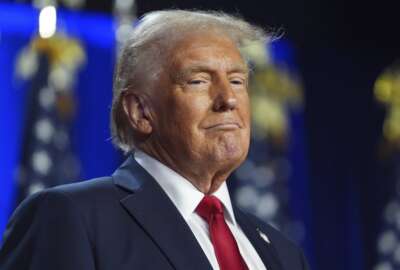Trump’s promise to revive Schedule F could become a ‘prompt’ reality
The reappearance of a policy similar to Schedule F is likely, federal workforce experts say. But it would look different in a second Trump term.
Worried about Schedule F and the future of your job? Excited to see if DOGE can improve government efficiency? Want to know more about the proposed pick to head up your department? Federal News Network is tracking all things transition-related, as the 47th administration’s plans for the federal workforce take shape. Visit our Tracking the Transition page to keep up with the latest developments.
For the career civil service, there are still many unknowns in the days following President-elect Donald Trump’s 2024 election win. But many longtime federal workforce experts are at the very least anticipating a revival of Schedule F.
The executive order Trump signed in October 2020 made it possible for agencies to reclassify certain career federal workers in policy-related roles to a new “Schedule F” category of employment. If the order had been fully implemented, any employees moved into the new Schedule F classification would have seen their civil service protections removed, making them at-will employees and giving agencies much more flexibility to fire them.
But because Trump signed the order just a few weeks before the November 2020 election, the policy didn’t see much light of day. President Joe Biden, after winning the election, revoked the Schedule F executive order during his first month in office.
The reappearance of a policy similar to Schedule F is likely, but it would look different in a second Trump term. Robert Shea, a former associate director at the Office of Management and Budget during the George W. Bush administration, said a main distinction would be its arrival at the beginning, rather than the end, of the term.
“[Schedule F] is a muscle that they’ve already exercised, so they know what it takes,” Shea said. “I have no reason to believe they wouldn’t do exactly that same thing as soon as practical.”
Project 2025, a blueprint for a presidential transition from the conservative think tank Heritage Foundation, directly called for a return of Schedule F, saying it “must be reinstituted.” The foundation did not return Federal News Network’s request for comment.
On the campaign trail, Trump distanced himself from Project 2025. But his “Agenda 47” campaign plan from March 2023 detailed 10 steps for dismantling what he has described as the “deep state” in government. The first point on that list is reissuing the 2020 executive order on Schedule F.
Trump’s transition team did not respond to Federal News Network’s request for comment on any specific plans from the incoming administration to reimplement Schedule F, or if there would be any changes to Trump’s federal personnel policies in a second term.
It’s unclear how broadly Schedule F would impact career federal employees. Early estimates stated that the original executive order, if implemented, would have affected up to about 50,000 employees in policy-related roles. But by more recent estimates, Schedule F could have extended to hundreds of thousands of positions.
“[In Trump’s first term] it was short-lived,” said Jim Eisenmann, a partner at Alden Law Group specializing in federal employment. “Now it’s going to be ever-present, and something that will provide, unfortunately, a deal of uncertainty and anxiety to federal employees, federal managers and supervisors, leaders and organizations.”
Trump faces new “delay” to Schedule F
Incoming Trump officials, however, would face a new obstacle if they plan to reinstate Schedule F. Earlier this year, the Biden administration took action aiming to prevent Schedule F’s return by issuing a final rule to clarify and reinforce job protections for career federal employees.
Senior Biden administration officials said the anti-Schedule F final rule from the Office of Personnel Management is the strongest step possible, absent the passage of a law, for maintaining job protections for career government workers.
But those familiar with the government’s rulemaking process said regulations that are done, can just as easily be undone. Through the government’s rulemaking process, the incoming Trump administration would theoretically be able to undo OPM’s final rule and issue its own.
For Shea, OPM’s final rule poses no real barrier to Schedule F’s “prompt” implementation.
“I don’t think it’s an impediment to the Trump administration’s implementation of Schedule F at all,” Shea said. “If they adhere to the requirements of notice and comment, that’ll be months of delay, but not very many … But this is a non-traditional administration, and it’ll be interesting to see whether they adhere to those or ignore them.”
The government’s rulemaking process usually takes several months. It involves drafting a proposed rule, working with the Office of Information and Regulatory Affairs and going through a public notice process. It took OPM just under seven months to propose and subsequently finalize the regulations securing job protections for career federal workers. The Administrative Procedure Act, a law from 1946, defines the standards for how agencies propose and finalize regulations.
Based on how the regulations are written or what’s being changed, the rulemaking process can be shortened in some cases. Ron Sanders, a long-time career federal executive who served as chairman of the Federal Salary Council during the first Trump administration, said for example it’s possible for an administration to implement an “interim” final rule.
“That would make that speed bump even smaller and the delay even less,” said Sanders, who resigned in 2020 in response to Trump’s Schedule F executive order.
Typically, proposed regulations on the Federal Register require a period for collecting public comments, which an agency then has to review before finalizing the rule. But an agency can also choose to publish an interim final rule, which is effective immediately upon publication, though still open to public comments afterward. And in cases where regulations are deemed “routine or uncontroversial,” an agency can issue a “direct” final rule.
While the rulemaking process is underway, experts said issuing an executive order on Schedule F at the start of the second Trump term would still be likely, for agencies to begin identifying the specific career positions that would be affected.
How Schedule F might look in practice
Schedule F’s impacts would depend largely on how agencies choose to implement it. Based on the stated and implied goals of Schedule F, Jenny Mattingley, vice president for government affairs at the Partnership for Public Service, sees two potential underlying narratives.
“One is that an incoming administration might perceive federal workers as not being open to the new policies, and needing more political loyalty in a federal workforce,” Mattingley said. “The other piece is the poor performer piece — the narrative that’s gone on for years that you can’t fire federal employees … It really depends on which one of those is your goal.”
“At its most reasonable, [Schedule F] reminds people that [an administration’s] priorities, irrespective of your personal views, ought to be implemented with fealty,” Shea said. “On the other hand, if you are holding people accountable for some tweet they made during the previous election, or you don’t agree with their personal views, then that’s a less benign implementation that I think would do real damage.”
Regardless, Sanders said in practice, removing and replacing career federal employees with enough “political loyalists” would be difficult and time-consuming.
“I think they’re going to have a hard time finding enough of them to even have a modicum of qualifications to do all of these jobs,” Sanders said.
Several federal workforce experts also raised concerns about Schedule F worsening an issue that’s already a big problem: the high number of political leadership vacancies across government. In effect, Schedule F would increase the number of political appointees an administration would need to make.
“There are already 4,000 positions an incoming president can make — it’s very difficult for them to fill those 4,000 positions,” Mattingley said. “It really hampers agencies in moving some of their work forward when we have all these vacancies. From a purely logistical standpoint of increasing political appointees by that magnitude, it potentially can cause a lot of organizational performance issues and service delivery issues for agencies.”
“Adding a large number of vacancies that result from Schedule F is not going to help accelerate hiring in the federal government,” Shea said. “Maybe that’s an outcome the administration hopes for, but in the end, it’ll really handicap their ability to execute their agenda.”
Experts recommend a focus on hiring, not firing
If the administration’s goal is indeed to address poor performance in the federal workforce, Mattingley said the focus should be on fixing the government’s existing performance management system, which has its own problems.
“Supervisors are not really trained in how to do good performance management. Employees also aren’t really trained in how to write good performance goals,” Mattingley said. “Every agency is different, every team is different, but by and large, people don’t really understand and use the performance management system.”
To make real steps toward effective civil service reform, Mattingley said the priority should be on improving the federal hiring process, rather than focusing time and energy on firing feds.
Many experts see career federal employees as providing stability and support to bridge the government’s ability to perform effectively while transcending presidential administrations. Without the expertise of career civil servants, it becomes much harder for an administration’s incoming political leaders to execute their agenda and policy goals.
“By and large, over and over again, we’ve heard political appointees say, ‘I didn’t realize this was what the agency did. I didn’t realize these were the jobs that federal employees did. I didn’t realize the impact that this agency has,’” Mattingley said. “The glass half full part of me says that, time and again, political appointees have come in and seen the work that federal employees do, and are supportive of it.”
Copyright © 2025 Federal News Network. All rights reserved. This website is not intended for users located within the European Economic Area.
Drew Friedman is a workforce, pay and benefits reporter for Federal News Network.
Follow @dfriedmanWFED






